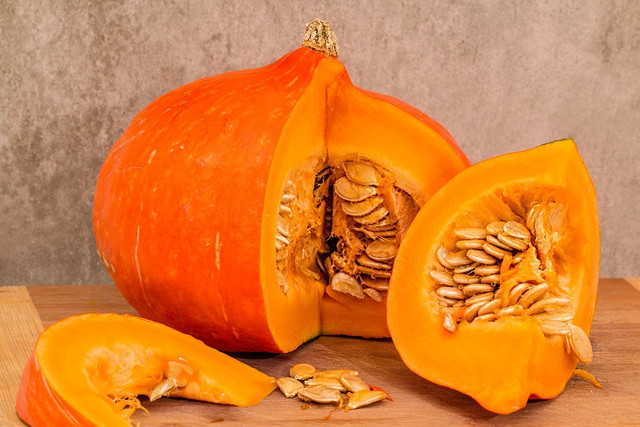Food coloring can contain unnatural additives and sometimes isn't suitable for vegans. We'll show you how to make orange food coloring in three natural ways.
Food coloring is used in baking to add brightness to frosting, cakes and dishes like pasta. However, avoiding artificial coloring may be better for you. For example, a 2012 study found that some children with hyperactivity saw improvements in a diet that restricted color additives. There is also evidence that artificial coloring could be linked to allergies.
On the other hand, natural food coloring is derived from fruit, vegetables or plants, making it much healthier overall. We’ll discuss how to make orange food coloring from three vegetables: carrots, pumpkin, and sweet potato. Each of these is easy to get hold of, can be organic, locally grown to reduce your carbon footprint, and chosen based on the season.
Bear in mind that the methods discussed below are the most energy efficient. Natural food dye can also be made by using a dehydrator that dries the vegetable for eight to twelve hours before it is pulverized to make a powder. However, that method is very energy-intensive and should be avoided.
Natural orange food coloring looks beautiful in frosting on cakes and cookies. Check out these recipes on how to make frosting; vegan cream cheese frosting uses sweet potato or nuts and quick and delicious dairy free-frosting uses vegan butter to get its creamy texture.
1. How to Make Orange Frosting Using Carrot Juice



(Foto: CC0 / Pixabay / Couleur)
Carrots are rich in color, high in vitamin A which helps to keep the eyes healthy, and flavonoids, which are good for digestion. Carrot juice can be used as a natural food coloring and has a mild taste so it won’t compete with other flavors.
Instructions:
- Wash and roughly chop two carrots (there is no need to peel them).
- Pulse in a blender until smooth, gradually add water if too thick.
- Pour through a sieve to remove any pulp.
Wondering how to make orange frosting with the result? Simply add half a teaspoon of carrot juice for every two tablespoons of frosting.
2. How to Make Orange Food Coloring with Pumpkin Purée



(Foto: CC0 / Pixabay / stevepb)
Pumpkin has a slightly sweet taste and is low in calories, it’s color is slightly lighter in color than carrots.
Instructions:
- To make pumpkin purée, peel and dice a small pumpkin into one-inch cubes, removing the seeds and pulp. Don’t discard the leftovers: you can eat pumpkin seeds — in fact, you can even eat pumpkin skins.
- Place the pumpkin on a parchment paper substitute on a baking tray and cook in the oven at 350°F for about twenty minutes, until soft. Alternatively, boil or steam the cubes until soft.
- Use a blender to purée the pumpkin. Add a little water if it is not liquid enough.
To make orange frosting using pumpkin, combine a quarter of a cup of pumpkin purée with every two tablespoons of frosting.
3. Using Sweet Potato to Make Orange Food Coloring



(Foto: CC0 / Pixabay / ivabalk)
Producing the lightest color of the three, sweet potatoes provide an earthy sweetness. They get their orange color from their high level of beta-carotene.
Instructions:
- Wash and dry one large sweet potato and pierce the skin several times with a fork.
- Bake in the oven at 400ºF for forty-five minutes to one hour, until the middle is very soft. Insert a knife into the center to test this. Remove from the oven and allow to cool.
- Chop the cooled potato in half and use a spoon to scoop out the contents into a bowl. Tightly press enough baked sweet potato into one measuring cup. Save any leftovers to make healthy mashed sweet potatoes.
- Pulse in a blender until smooth, gradually add a drop of water if too thick.
- Pour through a sieve to remove any pulp.
Combine a quarter of a cup of the sweet potato orange food coloring with every two tablespoons of frosting.
How to Make Orange Food Coloring Another Way



(Foto: CC0 Public Domain / Unsplash / Monstera)
Perhaps the above methods are too time-consuming for you, and you need an easier way of making orange coloring. You may already have some natural food coloring in the kitchen from previous baking sessions. To make orange all you need is natural red and yellow food coloring (this can be made from yellow beets or turmeric).
Combine them together to make the following shades of orange:
- Bright orange: Mix equal parts of natural red food coloring, with equal amounts of yellow, such as 6 drops each.
- Light orange: Mix one part of natural red food coloring with three parts of yellow.
- Dark orange: Follow the bright orange method and add a drop of natural blue food coloring (which can be made from red cabbage) or brown (made from coffee).
Read more:
- How to Make Black Food Coloring for Baking and Frosting
- 10 Easy Natural Dyes for Fabric (incl. Viscose & Linen)
- How to Make Homemade Playdough: An Easy DIY Recipe
Do you like this post?








